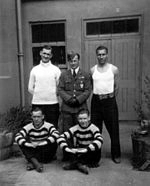How to Pronounce Franciszek Gruszka
#50
Most Popular
Boost
Jan 21, 1910 Lviv, Lviv Oblast, Ukraine Died on 18 Aug 1940 (aged 30)
Polish Air Force officer
AquariusFranciszek Gruszka, Date of Birth, Place of Birth, Family, Facts, Age, Net Worth, Biography and More in FamedBorn.com

Polish Air Force officer
Aquarius